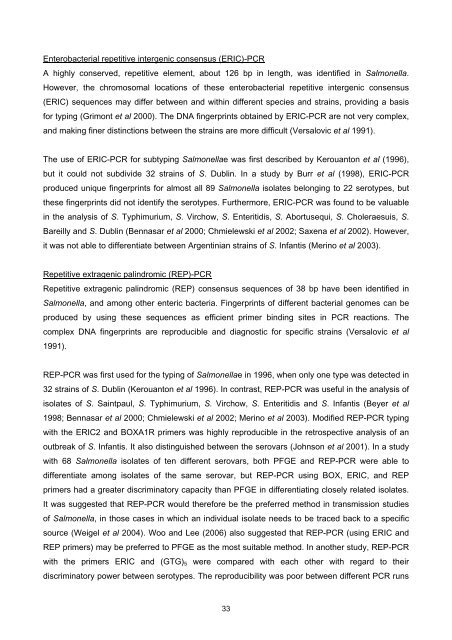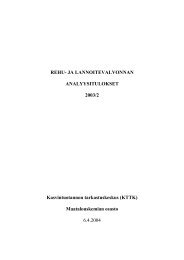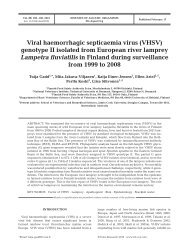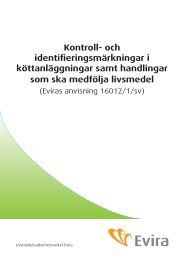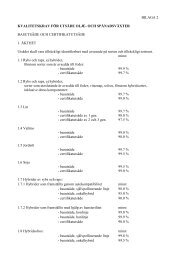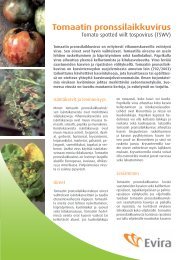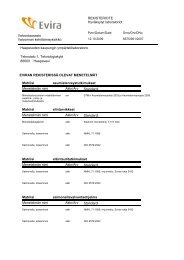Molecular characterization of endemic salmonella infections ... - Evira
Molecular characterization of endemic salmonella infections ... - Evira
Molecular characterization of endemic salmonella infections ... - Evira
You also want an ePaper? Increase the reach of your titles
YUMPU automatically turns print PDFs into web optimized ePapers that Google loves.
Enterobacterial repetitive intergenic consensus (ERIC)-PCR<br />
A highly conserved, repetitive element, about 126 bp in length, was identified in Salmonella.<br />
However, the chromosomal locations <strong>of</strong> these enterobacterial repetitive intergenic consensus<br />
(ERIC) sequences may differ between and within different species and strains, providing a basis<br />
for typing (Grimont et al 2000). The DNA fingerprints obtained by ERIC-PCR are not very complex,<br />
and making finer distinctions between the strains are more difficult (Versalovic et al 1991).<br />
The use <strong>of</strong> ERIC-PCR for subtyping Salmonellae was first described by Kerouanton et al (1996),<br />
but it could not subdivide 32 strains <strong>of</strong> S. Dublin. In a study by Burr et al (1998), ERIC-PCR<br />
produced unique fingerprints for almost all 89 Salmonella isolates belonging to 22 serotypes, but<br />
these fingerprints did not identify the serotypes. Furthermore, ERIC-PCR was found to be valuable<br />
in the analysis <strong>of</strong> S. Typhimurium, S. Virchow, S. Enteritidis, S. Abortusequi, S. Choleraesuis, S.<br />
Bareilly and S. Dublin (Bennasar et al 2000; Chmielewski et al 2002; Saxena et al 2002). However,<br />
it was not able to differentiate between Argentinian strains <strong>of</strong> S. Infantis (Merino et al 2003).<br />
Repetitive extragenic palindromic (REP)-PCR<br />
Repetitive extragenic palindromic (REP) consensus sequences <strong>of</strong> 38 bp have been identified in<br />
Salmonella, and among other enteric bacteria. Fingerprints <strong>of</strong> different bacterial genomes can be<br />
produced by using these sequences as efficient primer binding sites in PCR reactions. The<br />
complex DNA fingerprints are reproducible and diagnostic for specific strains (Versalovic et al<br />
1991).<br />
REP-PCR was first used for the typing <strong>of</strong> Salmonellae in 1996, when only one type was detected in<br />
32 strains <strong>of</strong> S. Dublin (Kerouanton et al 1996). In contrast, REP-PCR was useful in the analysis <strong>of</strong><br />
isolates <strong>of</strong> S. Saintpaul, S. Typhimurium, S. Virchow, S. Enteritidis and S. Infantis (Beyer et al<br />
1998; Bennasar et al 2000; Chmielewski et al 2002; Merino et al 2003). Modified REP-PCR typing<br />
with the ERIC2 and BOXA1R primers was highly reproducible in the retrospective analysis <strong>of</strong> an<br />
outbreak <strong>of</strong> S. Infantis. It also distinguished between the serovars (Johnson et al 2001). In a study<br />
with 68 Salmonella isolates <strong>of</strong> ten different serovars, both PFGE and REP-PCR were able to<br />
differentiate among isolates <strong>of</strong> the same serovar, but REP-PCR using BOX, ERIC, and REP<br />
primers had a greater discriminatory capacity than PFGE in differentiating closely related isolates.<br />
It was suggested that REP-PCR would therefore be the preferred method in transmission studies<br />
<strong>of</strong> Salmonella, in those cases in which an individual isolate needs to be traced back to a specific<br />
source (Weigel et al 2004). Woo and Lee (2006) also suggested that REP-PCR (using ERIC and<br />
REP primers) may be preferred to PFGE as the most suitable method. In another study, REP-PCR<br />
with the primers ERIC and (GTG)5 were compared with each other with regard to their<br />
discriminatory power between serotypes. The reproducibility was poor between different PCR runs<br />
33


